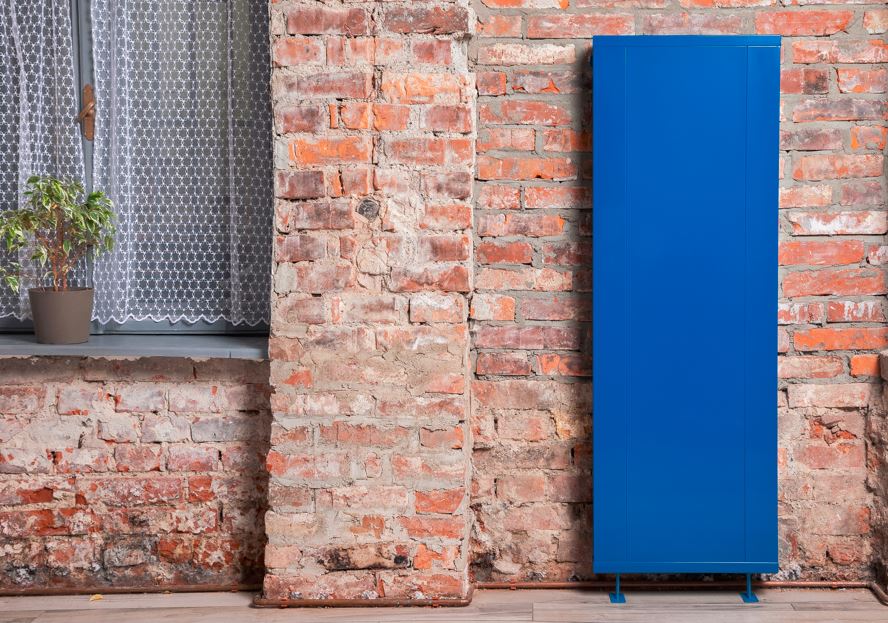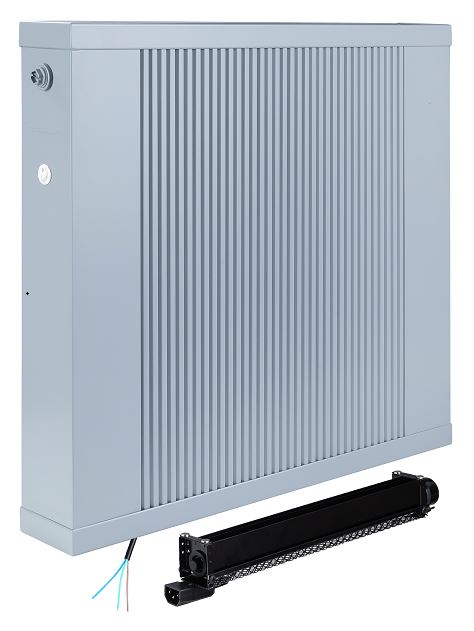A guide for sellers and installers of heat pumps
Is it possible to increase the power of radiators ? Yes! This can be done by increasing the supply temperature and air circulation forced by a fan. Fans in a heat pump installation are also a way to centrally cool rooms - universal, year-round use.

Increasing the supply temperature with underfloor heating
When we have an easily controllable heat source with a large range of available heating power, such as an electric, oil or gas boiler, the answer to the question is simple: the temperature of the heating medium should be increased. An increase in Tz by 1°C translates into an increase in the heating power of 1 m² of each surface type of radiator by an average of 10 W. Therefore, the larger the heating surface of the radiator, the greater the heating effect will be achieved by increasing its operating temperature. The largest surface area is the underfloor heater. Raising the temperature of 100 m² of floor by 1°C will increase the heating power by 1 kW, but to achieve this effect, we must "charge" the floor with a huge amount of heat. The weight of 100 m² of flooring is on average 20 tons! Due to the enormous thermal inertia of underfloor heating, there is no quick heating effect. Low-temperature underfloor heating has the disadvantage of low controllability, which manifests itself mainly in transitional periods with very variable heating needs. Then it is easy for the rooms to be under or overheated.
Check out Regulus radiators in the Onninen offer
Increasing the heating surface in wall radiators
Among wall radiators, the largest exchange surface is provided by copper-aluminum radiators from REGULUS®-system. It is almost 50% larger than panel radiators of similar size. Is it possible to enlarge the heating surface of this type of radiators even more? Of course. But the current density of aluminum fins that make up the radiator body is optimal for the appropriate level of free convection (these radiators also heat through radiation from the surface). Further thickening of the fins would increase the resistance to air flow through the interior of the radiator to such an extent that the radiator would only heat by assisted air blowing through its interior, as is the case in fan coil units or car radiators.

Which radiator should I choose for my heat pump? Choose a wall radiator with a fan!
Which radiators should you choose for heat pumps? Low-temperature heating forces a different approach to the issue. In order to increase the power of the radiator, you need to remove the heated air from its surroundings as quickly as possible, i.e. force the air to move through the radiator and around it . The effect is colossal - it is possible to increase the heating power of the radiator by up to 60% without changing the size of the radiator! All you need to do is add forced air circulation thresholds (gear control) and you have a multi-stage "gearbox" of heating power. We gain an important advantage when our heat needs are very variable, which results from the specificity of the Polish climate.
 When someone hears "radiators with a fan", associations with "farelka" arise. Meanwhile, the so-called Regulus E-VENT series of radiators and the Regulus REVERS series of radiators installed in the radiators Transverse fans (long, narrow, cylindrical) operate at a noise level of about 30 dB (30 dB is a quiet whisper heard from a distance of 1 m), and the power consumption of such a fan is only a dozen or so W.
When someone hears "radiators with a fan", associations with "farelka" arise. Meanwhile, the so-called Regulus E-VENT series of radiators and the Regulus REVERS series of radiators installed in the radiators Transverse fans (long, narrow, cylindrical) operate at a noise level of about 30 dB (30 dB is a quiet whisper heard from a distance of 1 m), and the power consumption of such a fan is only a dozen or so W.
E-VENT and REVERS radiators are identical, the so-called base radiators - on the bottom they have a recess for the fan and elements for quick connection and removal (mounting with magnets). Additionally, they are equipped with a complete internal electrical installation with a discreet switch located on the side casing.
Fans can be installed under any type of radiator, e.g. the universal Zephyr-Vent radiator fan. This is a way to significantly increase power, especially valuable for house owners whose boiler replacement has caused their radiators to heat too weakly, and therefore they are looking for ways to solve the problem relatively cheaply.
Check out Regulus radiators in the Onninen offer
Room cooling using a fan and heat pump
If someone decides to buy a heat pump, why should they consciously and voluntarily give up the possibility of using it for cooling purposes? Similarly, the holder of a GHE (ground heat exchanger). However, it is not possible to effectively cool rooms without forced air circulation - the colder air must be actively mixed with the warm air above. A very good way to centrally cool rooms or rooms are equipped with quietly operating fans and REVERS heaters. Universal radiator fans (Zephyr-Vent) can also be used for this purpose. Universal, i.e. one that can be installed under any type of radiator.
The lack of reversible heaters or heater fans in the installation precludes the effective use of the heat pump for cooling. An alternative are much more expensive fan coil units, the operation of which ALWAYS requires the fan to operate, both during heating and cooling. Meanwhile, after easily removing the fan from the reversible radiator, it can operate like a "normal radiator" for most of the heating season.
Good to remember:
- low-temperature radiators enable effective heating using a heat pump;
- when changing to low-temperature heating, there is no need to change radiators to larger ones;
- an effective and cheap way to increase the heating power of a radiator is to intensify air circulation around it;
- there is no effective cooling without forced air circulation;
- operational advantages of REGULUS®-system radiators: uniquely high efficiency and dynamics of operation, controllability, universal, year-round use. Colored, decorative, wall and floor channel radiators.